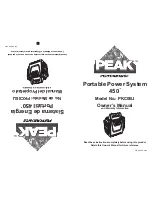
4
Introduction
General remarks
This vehicle, which complies with EC homologation parameters, uses
advanced technology and is capable of achieving high performance
levels. It is equipped with sophisticated active and passive safety systems
(described below). These safety features and systems do not authorise
the driver to take risks other than those involved in normal driving
since their preventive and protective action is guaranteed only in certain
conditions. Unless otherwise instructed specifically by F
ERRARI
(see the
Safety chapter), the deactivation of any of the vehicle’s safety systems is
PROHIBITED.
While certain safety systems (e.g. the airbags) have been tested to
ensure that they offer the highest possible levels of protection, they may
nonetheless be hazardous in the event of failure by the driver or passenger
to observe the instructions given by F
ERRARI
. All vehicle occupants
must be attentive at all times and take particular care when transporting
passengers who are more subject to injury such as children, disabled and
elderly persons.
Safe driving is subject to the following conditions AT ALL TIMES:
- the driver must be in perfect psycho-physical condition;
- road regulations (Traffic Regulations - Vienna Convention on Road
Traffic that ended on 8 November 1968) must be strictly observed;
- common rules of caution must always be observed in relation to the
quality/performance of the vehicle, driving conditions and contingent
situations.
- Caution and discipline are the basis of safe driving.
- Driving takes place in a naturally dangerous context in which a
number of different risk factors interact. For this reason, drivers
must drive bearing in mind that others, whether they are pedestrians,
motorcyclists or motorists, can make mistakes. Keeping a safe distance
allows emergency measures to be taken. Remember that national and
international legislation requires that the driver of the vehicle must be
capable of performing corrective and/or emergency manoeuvres at all
times.
- Correct and careful use of a vehicle derives, above all, from respect for
one's own safety and that of others as well as from compliance with road
regulations. Only this respect will help you experience all the emotions
that driving this car can offer you.
The driver MUST NEVER allow passengers to increase the risks
associated with driving (e.g. by not using safety systems such as the seat
belts) by failing to observe the mandatory safety rules that apply to both
driver and passengers.
The vehicle MUST NOT be modified or tampered with for any reason
whatsoever since, by so doing, the manufacturer's homologation and
safety parameters will be modified.
The driver must pay the utmost attention to the signals of the
vehicle and, in particular, the warning lights on the dashboard and
buzzers. Even when the warning lights do not indicate a situation of
immediate danger, the driver must be cautious in relation to possible
consequences/degeneration of the failure and other information given.
During routine operations, such as refuelling, precautions should always
been taken and it is important to check that flammable liquid has not
been spilled; these precautions must be observed even if the operation
is performed by others. Similarly, before setting off make sure that
the doors are closed by checking the warning lights and also manually.
The driver must be fully acquainted with the vehicle and its controls in
order to handle and drive it correctly. Command of the vehicle can be
acquired/improved by attending the driving courses held by F
ERRARI
which we strongly recommend.
The use of terms from the motor sports world (such as F1, SPORT
and RACE) is merely indicative of the vehicle's competition-derived
technology and does not endorse inappropriate behaviour on the road
which does not comply with Traffic Regulations.
Содержание Portofino
Страница 1: ......
Страница 3: ......
Страница 9: ...Introduction 9 ...
Страница 11: ...1 GENERAL ...
Страница 14: ...14 GENERAL ...
Страница 20: ...20 GENERAL ...
Страница 21: ...1 GENERAL 21 Identification and homologation plates and labels A D E F G L P G C B Q R N M H O I ...
Страница 24: ...24 GENERAL E ECE homologation F Checking the engine oil level G Passenger side airbag warning H Chassis number ...
Страница 25: ...1 GENERAL 25 I Vehicle identification L Unleaded fuel M Tyre type and pressure N TPMS present warning ...
Страница 26: ...26 GENERAL O Gearbox type and number P Original paintwork Q Engine type and number R Assembly number ...
Страница 28: ...28 GENERAL ...
Страница 29: ...1 GENERAL 29 2670 4586 1633 2090 1645 1318 ...
Страница 33: ...1 GENERAL 33 Warning Maximum permissible speed with winter tyres is 240 km h ...
Страница 41: ...2 SAFETY ...
Страница 71: ...2 SAFETY 71 ...
Страница 73: ...3 ABOUT YOUR VEHICLE ...
Страница 80: ...80 ABOUT YOUR VEHICLE ...
Страница 81: ...3 ABOUT YOUR VEHICLE 81 Instrument panel 6 5 1 5 3 7 2 5 4 5 View of vehicle instrument panel ...
Страница 154: ...154 ABOUT YOUR VEHICLE Warning Check that the deflector has been secured correctly ...
Страница 155: ...3 ABOUT YOUR VEHICLE 155 ...
Страница 157: ...4 ADVICE FOR EMERGENCY SITUATIONS ...
Страница 185: ...4 ADVICE FOR EMERGENCY SITUATIONS 185 ...
Страница 187: ...5 CARE OF THE VEHICLE ...
Страница 197: ...5 CARE OF THE VEHICLE 197 ...
Страница 198: ...Glossary 200 ...
Страница 199: ...6 GLOSSARY ...
Страница 202: ......
Страница 203: ...7 INDEX ...





































